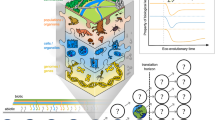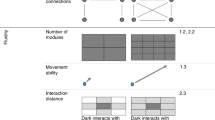Abstract
Regime shifts have been documented in a variety of natural and social systems. These abrupt transitions produce dramatic shifts in the composition and functioning of socioecological systems. Existing theory on ecosystem resilience has only considered regime shifts to be caused by changes in external conditions beyond a tipping point and therefore lacks an evolutionary perspective. In this study, we show how a change in external conditions has little ecological effect and does not push the system beyond a tipping point. The change therefore does not cause an immediate regime shift but instead triggers an evolutionary process that drives a phenotypic trait beyond a tipping point, thereby resulting (after a substantial delay) in a selection-induced regime shift. Our finding draws attention to the fact that regime shifts observed in the present may result from changes in the distant past, and highlights the need for integrating evolutionary dynamics into the theoretical foundation for ecosystem resilience.
This is a preview of subscription content, access via your institution
Access options
Access Nature and 54 other Nature Portfolio journals
Get Nature+, our best-value online-access subscription
$29.99 / 30 days
cancel any time
Subscribe to this journal
Receive 12 digital issues and online access to articles
$119.00 per year
only $9.92 per issue
Buy this article
- Purchase on Springer Link
- Instant access to full article PDF
Prices may be subject to local taxes which are calculated during checkout




Similar content being viewed by others
Data availability
No data were collected or used in this study.
Code availability
The implementation of the Escalator Boxcar Train numerical method and the PSPM package used to analyse the model can be found in https://staff.fnwi.uva.nl/a.m.deroos/EBT/Software/index.html and https://staff.fnwi.uva.nl/a.m.deroos/PSPManalysis/index.html, respectively.
References
Scheffer, M., Carpenter, S., Foley, J. A., Folke, C. & Walker, B. Catastrophic shifts in ecosystems. Nature 413, 591–596 (2001).
May, R. M. Thresholds and breakpoints in ecosystems with a multiplicity of stable states. Nature 260, 471–477 (1976).
Drijfhout, S. et al. Catalogue of abrupt shifts in Intergovernmental Panel on Climate Change climate models. Proc. Natl Acad. Sci. USA 112, E5777–E5786 (2015).
Winkelmann, R. et al. Trajectories of the Earth system in the Anthropocene. Proc. Natl Acad. Sci. USA 115, 8252–8259 (2018).
Scheffer, M. et al. Early-warning signals for critical transitions. Nature 461, 53–59 (2009).
Guttal, V. & Jayaprakash, C. Changing skewness: an early warning signal of regime shifts in ecosystems. Ecol. Lett. 11, 450–460 (2008).
Carpenter, S. R. et al. Early warnings of regime shifts: a whole-ecosystem experiment. Science 332, 1079–1082 (2014).
Scheffer, M. Critical Transitions in Nature and Society (Princeton Univ. Press, 2009).
DeMenocal, P. et al. Abrupt onset and termination of the African Humid Period: rapid climate responses to gradual insolation forcing. Quat. Sci. Rev. 19, 347–361 (2000).
Hare, S. R. & Mantua, N. J. Empirical evidence for North Pacific regime shifts in 1977 and 1989. Prog. Oceanogr. 47, 103–145 (2000).
Walther, G. R. Community and ecosystem responses to recent climate change. Phil. Trans. R. Soc. B 365, 2019–2024 (2010).
Parmesan, C. Ecological and evolutionary responses to recent climate change. Annu. Rev. Ecol. Evol. Syst. 37, 637–669 (2006).
Singer, M. C., Thomas, C. D. & Parmesan, C. Rapid human-induced evolution of insect–host associations. Nature 366, 681–683 (1993).
Allendorf, F. W. & Hard, J. J. Human-induced evolution caused by unnatural selection through harvest of wild animals. Proc. Natl Acad. Sci. USA 106, 9987–9994 (2009).
Olsen, E. M. et al. Maturation trends indicative of rapid evolution preceded the collapse of northern cod. Nature 428, 932–935 (2004).
Palumbi, S. R. & Mu, P. Humans as the World’s greatest evolutionary force: the pace of human-induced evolution. Science 293, 1786–1791 (2001).
Parvinen, K. & Dieckmann, U. Self-extinction through optimizing selection. J. Theor. Biol. 333, 1–9 (2013).
Schreiber, S. & Rudolf, V. H. W. Crossing habitat boundaries: coupling dynamics of ecosystems through complex life cycles. Ecol. Lett. 11, 576–587 (2008).
Knight, T. M., McCoy, M. W., Chase, J. M., McCoy, K. A. & Holt, R. D. Trophic cascades across ecosystems. Nature 437, 880–883 (2005).
Werner, E. E. & Gilliam, J. F. The ontogenetic niche and species interactions in size-structured populations. Ecology 15, 393–425 (1984).
Diehl, S. & Eklov, P. Effects of piscivore-mediated habitat use on resources, diet, and growth of perch. Ecology 76, 1712–1726 (1995).
Hobson, K. A. Tracing origins and migration of wildlife using stable isotopes: a review. Oecologia 120, 134–326 (1999).
de Roos, A. M. & Persson, L. Competition in size-structured populations: mechanisms inducing cohort formation and population cycles. Theor. Pop. Biol. 63, 1–16 (2003).
Hendry, A. P., Farrugia, T. J. & Kinnison, M. T. Human influences on rates of phenotypic change in wild animal populations. Mol. Ecol. 17, 20–29 (2008).
Bone, E. & Farres, A. Trends and rates of microevolution in plants. Genetica 112–113, 165–182 (2001).
Lande, R. & Shannon, S. The role of genetic variation in adaptation and population persistence in a changing environment. Evolution 50, 434–437 (1996).
Woodward, G. & Hildrew, A. G. Body-size determinants of niche overlap and intraguild predation within a complex food web. J. Anim. Ecol. 71, 1063–1074 (2002).
Brose, U. et al. Predicting the consequences of species loss using size-structured biodiversity approaches. Biol. Rev. 92, 684–697 (2017).
Boyle, P. R. & Boletzky, S. Cephalopod populations: definition and dynamics. Phil. Trans. R. Soc. B. 351, 985–1002 (1996).
de Roos, A. M. & Persson, L. Population and Community Ecology of Ontogenetic Development (Princeton Univ. Press, 2013).
Hansen, J. H. et al. Ecological consequences of animal migration: prey partial migration affects predator ecology and prey communities. Ecosystems 22, 1–15 (2019).
Rudolf, V. H. W. & Rasmussen, N. L. Population structure determines functional differences among species and ecosystem processes. Nat. Commun. 4, 2318 (2013).
Zhou, S. et al. Ecosystem-based fisheries management requires a change to the selective fishing philosophy. Proc. Natl Acad. Sci. USA 107, 9485–9489 (2010).
Scheffer, M., Hosper, S., Meijer, M., Moss, B. & Jeppesen, E. Alternative equilibria in shallow lakes. Trends Ecol. Evol. 8, 275–279 (1993).
de Roos, A. M. & Persson, L. Size-dependent life-history traits promote catastrophic collapses of top predators. Proc. Natl Acad. Sci. USA 99, 12907–12912 (2002).
Gårdmark, A. et al. Regime shifts in exploited marine food webs: detecting mechanisms underlying alternative stable states using size structured community dynamics theory. Phil. Trans. R. Soc. B. 370, 20130262 (2015).
Biro, P. A. & Post, J. R. Rapid depletion of genotypes with fast growth and bold personality traits from harvested fish populations. Proc. Natl Acad. Sci. USA 105, 2919–2922 (2008).
Swain, D. P., Sinclair, A. F. & Hanson, J. M. Evolutionary response to size-selective mortality in an exploited fish population. Proc. Biol. Sci. 274, 1015–1022 (2007).
Rocha, J. C., Peterson, G. D. & Biggs, R. Regime shifts in the Anthropocene: drivers, risks, and resilience. PLoS ONE 10, e0134639 (2015).
Brunnermeier, M. K. Deciphering the liquidity and credit crunch 2007-08. J. Econ. Perspect. 23, 77–100 (2009).
Sih, A., Ferrari, M. C. O. & Harris, D. J. Evolution and behavioural responses to human-induced rapid environmental change. Evol. Appl. 4, 367–387 (2011).
Skelly, D. K. et al. Evolutionary responses to climate change. Conserv. Biol. 21, 1353–1355 (2007).
Persson, L., Leonardsson, K., de Roos, aM., Gyllenberg, M. & Christensen, B. Ontogenetic scaling of foraging rates and the dynamics of a size-structured consumer-resource model. Theor. Pop. Biol. 54, 270–293 (1998).
de Roos, A. M. in Structured-Population Models in Marine, Terrestrial, and Freshwater Systems (eds Tuljapurkar, S. & Caswell, H.) 119–204 (Springer Science & Business Media, 1997).
Lande, R. A quantitative genetic theory of life history evolution. Ecology 63, 607–615 (1982).
Durinx, M., Metz, J. A. & Meszéna, G. Adaptive dynamics for physiologically structured population models. J. Math. Biol. 56, 673–742 (2008).
de Roos, A. M. Numerical methods for structured population models: the Escalator Boxcar Train. Numer. Methods Partial Differ. Equ. 4, 173–195 (1988).
de Roos, A. M. PSPManalysis: A Package for Numerical Analysis of Physiologically Structured Population Models (Institute for Biodiversity and Ecosystem Dynamics, 2018); https://bitbucket.org/amderoos/PSPManalysis/
Acknowledgements
This research was supported by the European Research Council under the European Union’s Seventh Framework Programme (FP/2007-2013)/ ERC grant no. 322814.
Author information
Authors and Affiliations
Contributions
P.C.C.-P. and A.M.deR. designed methodology and gave final approval for publication. P.C.C.-P. conceived the ideas, analysed the results and led the writing of the manuscript. A.M.deR. developed the model formulation and contributed to later versions of the manuscript.
Corresponding author
Ethics declarations
Competing interests
The authors declare no competing interests.
Additional information
Publisher’s note Springer Nature remains neutral with regard to jurisdictional claims in published maps and institutional affiliations.
Extended data
Extended Data Fig. 1 Population compositions in the ASSs when the average body size at habitat switch equals 0.25.
The two ASSs correspond to low (solid line) and high biomass levels (dashed line) in the nursery habitat, and to high (solid line) and low biomass levels (dashed line) in the adult habitat. These alternative stable population compositions represent the population structure approximately at time 260 in Fig. 2 (before the regime shift in Fig. 2) and approximately at time 340 in Fig. 2 (after the regime shift in Fig. 2). The regime shift observed in Fig. 2 leads to a decrease in population density in the nursery habitat (green region) and an increase in population density in the adult habitat (blue region), mainly as a consequence of an increase in the density of immature individuals (smaller than the size at maturation). This increase in density of immature individuals in the adult habitat results in increased competition in this habitat that produces a reduction of 32% in the maximum asymptotic body size after the regime shift (reduction from 3.71 to 2.52). Parameter values as in Fig. 2.
Extended Data Fig. 2 Eco-evolutionary effects of trait variation in the population.
a) Ecological and b) evolutionary dynamics before and after a reduction of mortality in the adult habitat (vertical dotted line, from 2 to 1.5). When trait variation is represented with a truncated normal distribution with a minimum and maximum value equal to 80% and 120% (black lines) the regime shift occurs at time 390, whereas when the minimum and maximum value equal to 90% and 110% (grey lines) the regime shift occurs at time 940. Mortality in habitat 1 is 0.8, other parameters as in Table 1 (see Methods).
Extended Data Fig. 3 Long-term stability of the system.
Population biomass and food resource densities in the nursery and adult habitat and selection gradient as a function of body size at habitat switch after a decrease in mortality when the evolutionary endpoint occurs a) in one of the alternative stable ecological equilibrium resulting in a single regime shift (dynamics shown in Fig. 4a) and b) in the unstable equilibrium resulting in repeated delayed regime shifts (dynamics shown in Fig. 4b). Ecologically stable (solid lines) and unstable (dashed lines) equilibrium values are indicated with black lines as well as minimum and maximum densities during oscillatory dynamics (dotted lines). The direction of selection is indicated with thick arrows (orange when negative and blue when positive) and ecological dynamics with double vertical arrows (yellow). The evolutionary endpoint is indicated with a circle (open circle in case it corresponds to an unstable ecological equilibrium, filled circle if it correspond to a stable ecological equilibrium). The direction of selection (bottom plots) is positive at low values of the trait (blue shaded area), negative at high values (pink shaded area) and either negative or positive at intermediate values of the trait (mixed shaded area), depending on which of the two ASSs the population is in. Parameter values as in Fig. 4.
Supplementary information
Supplementary Information
Supplementary Notes 1–3.
Rights and permissions
About this article
Cite this article
Chaparro-Pedraza, P.C., de Roos, A.M. Ecological changes with minor effect initiate evolution to delayed regime shifts. Nat Ecol Evol 4, 412–418 (2020). https://doi.org/10.1038/s41559-020-1110-0
Received:
Accepted:
Published:
Issue Date:
DOI: https://doi.org/10.1038/s41559-020-1110-0
This article is cited by
-
Ecosystem Shifts: Implications for Groundwater Management
Environmental and Resource Economics (2021)



